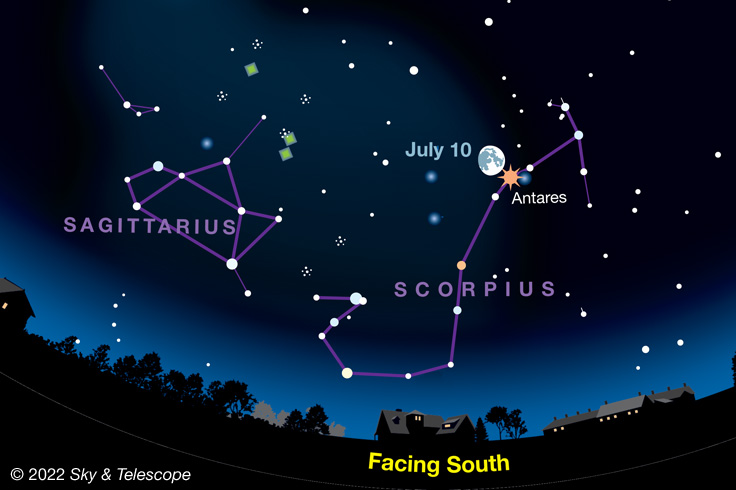July offers lots of pretty stars and constellations to check out, and you’ll get a personally guided tour of them by downloading this month’s Sky Tour astronomy podcast.

Listen Here:
Podcast: Play in new window | Download
Subscribe: Apple Podcasts | Google Podcasts | Spotify | Email | RSS | More
Throughout July, right after the Sun sets and it gets dark, you’ll have no bright planets in view — they’re all in the predawn sky. But there are lots of pretty stars and constellations to check out, and you’ll get a personally guided tour of them by downloading this month’s Sky Tour astronomy podcast. It’s a great way for anyone interested in the night sky to get a quick and entertaining overview of “what’s up” during July or any month of the year.
For example, after the Sun sinks from view, scan the western sky for bright stars. Easiest to spot is Arcturus, very bright and most of the way up from the southwestern horizon to overhead. Over to its right is the Big Dipper, seemingly hanging by its handle in the evening sky.
Almost directly below Arcturus is icy-white Spica, the alpha star in Virgo, the Maiden. It’s actually two stars whirling around each other so fast and so close that they’ve distorted each other into egg shapes. And it’s a good thing Spica is 850 light-years away — it outshines the Sun by more than 12,000 times with intense, lethally high-energy light. Not the kind of star you’d want to have right next door to our solar system. And do you know what Spica has to do with the flag of Brazil? Listen to Sky Tour for the answer!

Sky & Telescope
Well to the left of Spica is the bright star Antares, the heart of Scorpius. Can you tell that Antares has a reddish tinge compared to icy-white Spica? Antares is a red supergiant, about 550 light-years away, and it’s one of the largest stars known. To the left of Antares is a distinctive group of stars in the constellation Sagittarius that’s shaped like a Teapot. Download this month’s Sky Tour for tips on how to spot it. are shaped like a teapot. In fact, that’s what astronomers call it — the Teapot.
Although there’s been a lot of planet action in the predawn sky, the evening sky has been planet-less in recent weeks. That starts to change by the end of July, as Saturn and then Jupiter pop into view low in the east by late evening. To figure out where and when to look for them — and to heighten your enjoyment of all the bright stars and constellations now overhead — all you need is a little curiosity, a clear sky, and this month’s Sky Tour episode.
 4
4
Comments
Kevan Hubbard
July 1, 2022 at 7:38 pm
I won't look at Arcturus the same again as I was recently reading it is part of a moving cluster, the Arcturus Star Stream,which may come from a cannibalised dwarf galaxy.
You must be logged in to post a comment.
John Schnupp
July 3, 2022 at 2:07 pm
I was intrigued by your comments about Spica being represented on the flag of Brazil. Do you have a reference for this? I checked wikipedia [https://en.wikipedia.org/wiki/Flag_of_Brazil], "A blue circle with white five-pointed stars replaced the arms of the Empire of Brazil — its position in the flag reflects the sky over the city of Rio de Janeiro on November 15, 1889."
I used Stellarium to check this location and date and at that time Spica was only visible in the pre-dawn sky. The white band is the equitoral line, so a star above the line should have a positive RA...and Spica is -10. The only bright star I can see visible in the night sky over Rio de Janeiro on that night is Betelgeuse at RA +7. It would be interesting to know which stars in the sky are represented by the starts on the flag.
You must be logged in to post a comment.
John Schnupp
July 3, 2022 at 2:11 pm
I can't delete the comment. Never mind, much later in the article there is a drawing showing all the stars represented. https://en.wikipedia.org/wiki/Flag_of_Brazil#/media/File:Flag_of_Brazil_(dimensions).svg
You must be logged in to post a comment.
Josef Wolferseder
July 10, 2022 at 1:39 pm
An interesting event is on 8. July at 11:15 UTC. Every year 99% of mankind is more or less in sunlight simultaneously.
I get this information at EarthSky.org in column "Earth".
Kelly, you can mention this astonishing constellation in July 2023
You must be logged in to post a comment.
You must be logged in to post a comment.